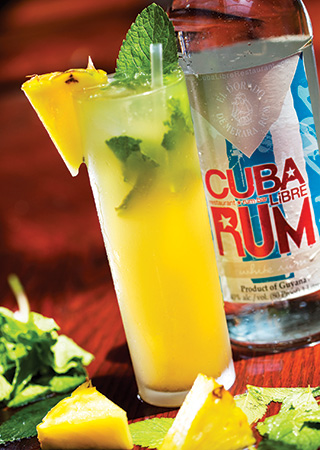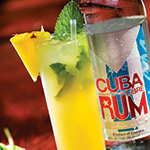There’s nothing like a mojito.
It’s crisp, light, sometimes fruity and always refreshing. It conjures images of poolside lounging, beach bummin’ and club-going. But this beloved Latin classic that’s come to symbolize summer fun is often incorrectly made. Here’s the definitive guide to making a proper mojito, from expert Vance Henderson, bar manager at Washington, D.C. hotspot Cuba Libre Restaurant & Rum Bar.
Mojito comes from mojo, the Spanish word meaning to assemble or blend. Like many classic cocktails, the origins of the mojito are fuzzy, but legend claims it originated when Cuban plantation masters began adding highly alcoholic sugarcane distillate to slaves’ energy-boosting sugar water. Over time, mint and lime were added. Fast forward a couple hundred years to the 20th century, and the easy-to-drink combination became the go-to cocktail at Havana‘s many bars and clubs, eventually making its way to the United States.
The difference between a perfect mojito and an average one is the quality of ingredients. Since rum is not regulated by an international body, there’s controversy over the perfect recipe for making quality levels of the spirit. It follows that rum-based cocktails, like the mojito, are often tainted by subpar alcohol made with synthetic sugars, added to sour mixes. When added to premium rum, fresh mojitos are lower-cal, healthier and tastier.
“The mojito must be all-natural. It must have a rustic flavor, no metallics [that ruin the simple taste],” says Henderson. And this guy knows what he’s talking about; Cuba Libre features a dozen signature mojitos and 98 rums to accompany its Cuban fare. “Fresh is always best. And mojitos are not meant to be strong and knock you on your butt.”
In the spirit of getting our future mojitos made correctly, we asked Henderson his best tips for making a classic mojito. Here’s how it’s done:
Always start with white rum. Rum, which is made from molasses, sugarcane juice or cane syrup can be white (unaged), golden or brown (aged in various types of wooden barrels). Since aged rums change a classic mojito‘s flavor with woody character, start with white rum for the purest expression of sugarcane. Once you experiment with various fruit mojitos and learn your rum preference, then change out the white with a higher proof or aged rum for spins on the classic.
Use guarapo rather than simple syrup. Squeezing the green-colored juice from sugarcane stalks is the most authentic way to sweeten a mojito. Stalks can be purchased at some natural food stores, such as Whole Foods, peeled and extracted with a high-powered electric juicer. When making fresh guarapo is not possible, combine one part raw or unprocessed sugar with one part water on a stovetop until dissolved. Remove from heat and let cool before mixing into the mojito.
Tear, rather than muddle, fresh mint leaves. When shaken with ice, torn mint releases its essential oils more easily, becoming more aromatic. Muddled leaves, on the other hand, retain much of the fresh flavor characteristic of the drink. The quality of mint also counts. Henderson recommends Israeli mint when possible, which contains more oils. Make sure mint leaves are not dry or browning.
Avoid bottled lime juice and sour mix. Limes are widely available most of the year and easily extracted for fresh juice, whereas bottled lime juices contain unnecessary preservatives. Choose limes that are somewhat firm and roll one to loosen juices before squeezing.
Ready to get your real mojito on? Here are two recipes courtesy of Cuba Libre in Washington, D.C. and resident mixologist and bar manager, Vance Henderson.
- 1 1/2 ounces white rum
- splash of soda
- 2 1/2 ounces guarapo (sugarcane juice)
- 1 1/4 ounces fresh lime juice
- 6 mint leaves
Click here for the full recipe.
- 1 1/4 ounces Cuba Libre White Rum
- 1 1/4 ounces fresh lime juice
- 2 1/2 ounces guarapo
- 2 tablespoons grilled pineapple puree
- 6 sprigs of mint
- top with Sprite
Vance Henderson, Beverage Manager and Nightlife Manager of Cuba Libre Restaurant & Rum Bar is originally from Pleasantville, NJ. After relocating to Washington, DC in 2002, he became the owner of Flavor Ink Catering as well as the Founder and Contributing Chef of Supperwhere?, an underground dining collective in The District.





![Making Mealtime Matter with La Familia: Easy Sofrito [Video]](https://thelatinkitchen.com/wp-content/uploads/2015/10/sofrito-shutterstock__0-500x383.jpg)
![Easy Latin Smoothies: Goji Berry Smoothie [Video]](https://thelatinkitchen.com/wp-content/uploads/2015/12/goji_berry-shutterstock_-500x383.jpg)
















![Fun and Fast Recipes: Fiesta Cabbage Salad [Video]](https://thelatinkitchen.com/wp-content/uploads/2015/11/fiesta_cabbage_slaw-shutterstock_-500x383.jpg)









